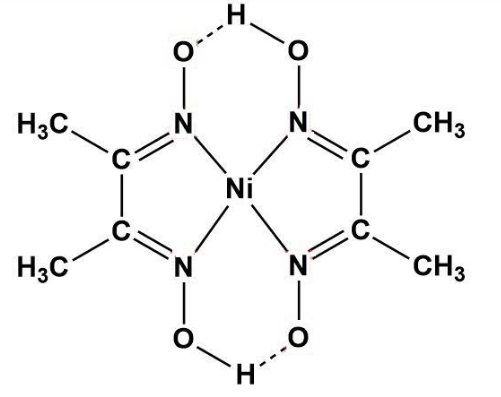
Answer
420.9k+ views
Hint: The red coloured complex is the product in the form of precipitate which is produced when an alcoholic solution of dimethylglyoxime is added to an aqueous solution of nickel (II) chloride.
Also, it’s a hint that the valency of nickel will determine the complex formation and the number of hydrogen bonds formed.
Complete step-by-step answer: Let us discuss the reactants involved to form a product whose hydrogen bonds needs to be counted;
Dimethylglyoxime is the whitish crystalline solid with molecular formula of ${{C}_{4}}{{H}_{8}}{{N}_{2}}{{O}_{2}}$ (also known as 2, 3 – butadiene dioxide).
When $dmg{{H}_{2}}$ reacts with metals salts, a complex is formed i.e. metal-dmg is formed. So, in the case of nickel (II) chloride; the following displayed complex is formed.

Here, we can see that when $N{{i}^{2+}}$ reacts with $dmg{{H}_{2}}$, a Ni-dmg complex is formed having two hydrogen bonds (also as the valency of nickel is 2 in ionic form).
Therefore option (2) is correct.
Note:Dimethylglyoxime is actually used for the analysis and identification of nickel and palladium.
Specifically, for the nickel atom, the white coloured powder changes to a rosy red colour complex; hence, the presence of nickel is determined.
Also, it’s a hint that the valency of nickel will determine the complex formation and the number of hydrogen bonds formed.
Complete step-by-step answer: Let us discuss the reactants involved to form a product whose hydrogen bonds needs to be counted;
Dimethylglyoxime is the whitish crystalline solid with molecular formula of ${{C}_{4}}{{H}_{8}}{{N}_{2}}{{O}_{2}}$ (also known as 2, 3 – butadiene dioxide).
When $dmg{{H}_{2}}$ reacts with metals salts, a complex is formed i.e. metal-dmg is formed. So, in the case of nickel (II) chloride; the following displayed complex is formed.

Here, we can see that when $N{{i}^{2+}}$ reacts with $dmg{{H}_{2}}$, a Ni-dmg complex is formed having two hydrogen bonds (also as the valency of nickel is 2 in ionic form).
Therefore option (2) is correct.
Note:Dimethylglyoxime is actually used for the analysis and identification of nickel and palladium.
Specifically, for the nickel atom, the white coloured powder changes to a rosy red colour complex; hence, the presence of nickel is determined.
Recently Updated Pages
A very dilute acidic solution of Cd2+ and Ni2+ gives class 12 chem sec 1 JEE_Main

Calculate the equivalent resistance between A and class 12 physics JEE_Main

The potential difference between points A and B in class 12 physics JEE_Main

A wire is bent in the form of a triangle now the equivalent class 12 physics NEET_UG

For the circuit shown in figure the equivalent capacitance class 12 physics JEE_Main

If on applying the potential of 20 V on a conductor class 12 physics JEE_Main

Trending doubts
What are the major means of transport Explain each class 12 social science CBSE

What is the Full Form of PVC, PET, HDPE, LDPE, PP and PS ?

Name the part of the electromagnetic spectrum which class 12 physics CBSE

Define quantitative pollutants class 12 biology CBSE

When was the first election held in India a 194748 class 12 sst CBSE

The largest irrigation canal in india is A Indira Gandhi class 12 social science CBSE




